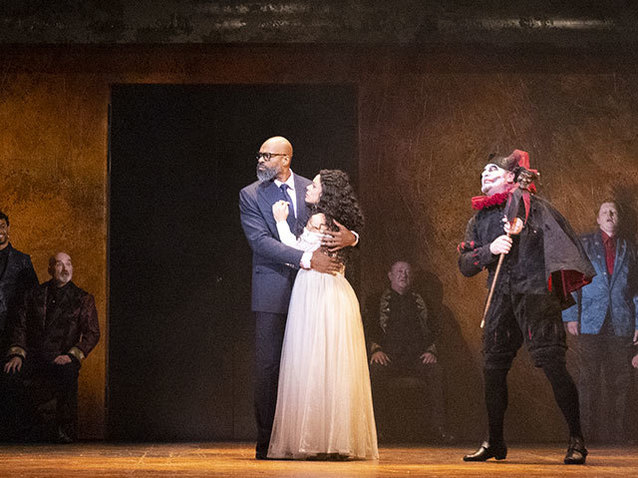 © Ellie Kurttz
© Ellie Kurttz
Based on Victor Hugo’s play Le roi s’amuse, Giuseppe Verdi’s Rigoletto was a triumph when it premiered at La Fenice in Venice in 1851, and has remained one of the composer’s most frequently performed operas ever since. Its popularity is thoroughly deserved but might still be deemed interesting, given that it is a contender for the cruellest opera in the mainstream repertoire. While many works see the innocent suffer and die, there is usually a sense in which virtue has triumphed if only by remaining defiant in the face of evil. In the case of Rigoletto, however, it is the character who is arguably the most wronged by life as a whole who ultimately suffers the most dreadful of fates.
Set in the sixteenth century, the story revolves around the Duke of Mantua’s hedonistic lifestyle and womanising ways. In his employment is the jester and hunchback Rigoletto whose job it is to entertain everyone, especially the Duke. He goes about his task with a merciless zeal, so that the victims of his mockery become irate in the extreme. At the same time he is a loving father to his daughter Gilda, who he tries to keep entirely apart from his public life. When the people do, however, learn of her existence, the problems created by this are compounded by the fact that Gilda has fallen in love with the Duke.
The latter’s infatuation with her is more temporary, but she has fallen so completely for him that when things come to a head she voluntarily puts herself in his place to ensure that she is killed instead of him. Thus Rigoletto, having conscripted the assassin Sparafucile to kill the Duke, is presented with a sack that he discovers contains his own daughter’s body.
It is possible to argue that Rigoletto is the master of his own downfall because he chose to pursue his unscrupulous public ways with a merciless zeal. Surely, however, the role of jester was imposed on him in the first place by a society that could never view a hunchback as anything other than a comic being. Having forced him to carve a niche in this profession to begin with, the great and the good then point the finger at him when they feel exposed, and it is he who suffers the most dreadful of fates while those who are really in control (in other words, the Duke) walk away unscathed.
This is the Royal Opera’s first new production of Rigoletto since 2001, with David McVicar’s version having seen the company through the past twenty years. No production enjoys such a long tenure without a considerable list of merits but, because it emphasised the hedonism, watching the Duke’s licentiousness play out in exactly the same way in revival after revival got wearing to say the least. This new offering from the Royal Opera’s Director of Opera Oliver Mears takes a more measured approach to the action, while introducing many thoughtful touches along the way.
The Overture sees a tableau vivant depicting Caravaggio’s ‘The Martyrdom of St Matthew’, only the aggressor is a Minotaur, who subsequently reveals himself to be the Duke, and the victim a woman. However, if the start of Act I in McVicar’s production was possibly too debaucherous, Mears, perhaps in an effort to put space between this and its predecessor, produces something that is arguably too sedate and stylised. There is the odd moment that reveals the Duke’s shocking behaviour to the full, but generally people enter and move slowly while the Duke sings ‘Questa o quella’ before a group of practically statuesque women. It may illustrate the way in which he sees them as objects, but the scene really needs to go with more of a swing, not least in order to match the music.
The setting is deliberately unspecific, with most of Ilona Karas’s costumes comprising simple dark and seemingly modern clothes, often with a colourful overgarment. In this way, the Duke with his belt and trousers could fancy himself as a connoisseur as he dons a pastiche of a sixteenth century jacket and collects paintings. This lack of specificity, however, introduces some problems. In Simon Lima Holdsworth’s set, Act I sees the interior of the Duke’s palace comprise a huge ‘rusted’ orange wall with a double door and painting of Titian’s ‘Venus of Urbino’. This wall then advances to form Rigoletto’s house, with the painting being removed to reveal a window into Gilda’s bedroom. Disconcertingly, there is no clear moment when Rigoletto leaves the street, having lamented his life, and enters his house to become a ‘different person’, as instead Gilda rushes through the double doors to meet him. This may seem a minor point but it blurs the all important divide between the jester’s public and private life, while the fairly nondescript area in which the subsequent action plays out presents its own difficulties.
The scene sees many people enter, exit and hide. It is therefore important for an audience to know who is where at each point and who can and cannot be seen (in the dark), and here people unfamiliar with the opera may struggle to grasp all that is happening. Watching the interactions of figures who move around a predominantly bare stage in an unspecified time does not help us feel for them as we are left wondering who they really are as people. The setting does not need to be the original, as Jonathan Miller’s 1982 Mafia version for English National Opera and Michael Mayer’s current 1960s Las Vegas version for the Metropolitan Opera prove, but a Rigoletto where we can clearly appreciate the context in which this human being is exploited will always arouse more sympathy than one in which the dynamics feel played out in the abstract.
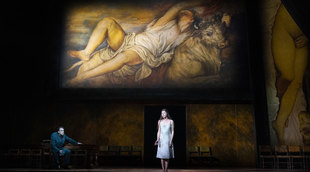
Carlos Álvarez and Lisette Oropesa, Rigoletto © 2021 ROH / Ellie Kurttz
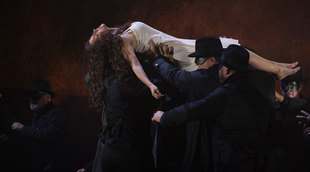
Lisette Oropesa, Rigoletto © 2021 ROH / Ellie Kurttz
Things pick up after the interval as the connections between how each of the scenes is staged become clearer, and the concept comes into focus more as representing the accumulative experience of the evening as a whole. Act II, back in the ducal palace, sees Titian’s ‘Venus of Urbino’ replaced by the artist’s ‘The Rape of Europa’ with the bull’s famously nonchalant face. The former now lies on its side as if to suggest that the Duke has set aside any notions of being the respectable art connoisseur and is now showing his true colours, especially since he was presented as a Minotaur during the Overture.
It is Act III, however, when things really fall into place as Sparafucile’s house represents a ‘cutaway’ of the ducal palace, and hence sees the completion of the ‘cycle’ of sets. This act provides what feels to be the most specific location, with the Mincio river where the Duke’s body will supposedly be dumped appearing in the background. Unlike the final scene of Act I, it is always easy to know who is where, both in and outside the house, and this helps to generate many chilling moments. Chief among them is the sight of Sparafucile’s sister Maddalena running up to be with the Duke even as the assassin bundles Gilda’s stabbed, bloodied body into a sack.
Sir Antonio Pappano’s conducting is strong, while the cast is headed by an excellent Carlos Álvarez who totally inhabits the title role as he combines a striking baritone with a concerned, and at times tortured, face. Liparit Avetisyan is an effective Duke who executes ‘La donna è mobile’ extremely well, Brindley Sherratt proves a first class, menacing Sparafucile and Ramona Zaharia throws herself completely into the role of Maddalena. It is, however, Lisette Oropesa, with her beautifully toned sound, who stands as the first among equals as she presents a Gilda who is totally overwhelmed by her delusion that the Duke really loves her. In the 2020/21 season Rigoletto runs initially until 29 September 2021 (Paul Wynne Griffiths conducts the final two performances) and then with a different cast between 18 February and 12 March 2022. There will be a live cinema screening on 10 March.
by Sam Smith
Rigoletto | 13 - 29 September 2021 | Royal Opera House, Covent Garden
the 19 of September, 2021 | Print
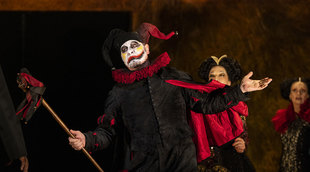
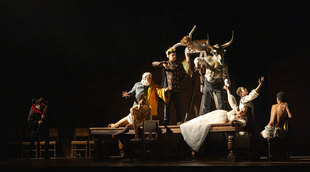
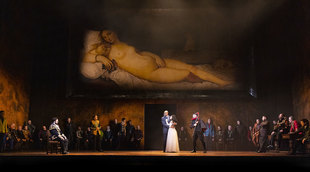
Comments